Best Trees for Urban Wildlife: Top 5 Species for 2024
Are you looking to transform your urban space into a wildlife haven ? You’re in the right place! In this comprehensive guide, we’ll explore the best trees for urban wildlife, focusing on the top five species that can make a real difference in your city’s ecosystem. Whether you’re a homeowner, a city planner, or a nature enthusiast, this article will help you choose the perfect trees to support urban wildlife in 2024.
The Importance of Trees in Urban Ecosystems

A Couple Enjoys the Shade of an Urban Tree – Photo by Benjamin Cheng on Unsplash
Before we dive into our top picks, let’s understand why trees are so crucial in urban settings. Trees play a vital role in supporting biodiversity by providing food, shelter, and nesting sites for various species. They’re not just pretty additions to our cityscapes; they’re lifelines for urban wildlife.
Benefits of Urban Wildlife for City Dwellers
Having wildlife in our cities isn’t just good for the animals—it’s great for us, too! Here’s why:
- Improved Mental Health and Well-being: Studies show that exposure to nature and wildlife can reduce stress, anxiety, and depression.
- Enhanced Air Quality: Trees and plants filter pollutants, improving the air we breathe.
- Natural Pest Control: Birds and beneficial insects help control pest populations naturally.
- Educational Opportunities: Urban wildlife provides hands-on learning experiences for children and adults about ecology and conservation.
- Increased Property Values: Homes in areas with diverse wildlife and green spaces often have higher property values .
- Climate Regulation: Trees help mitigate the urban island heat effect, making cities more comfortable.
Challenges Faced by Urban Wildlife
Urban animals face numerous obstacles:
- Habitat Fragmentation: Development breaks up natural areas, making it difficult for animals to move and find resources.
- Pollution: Air, water, and light pollution can harm wildlife and disrupt natural behaviors.
- Limited Food Sources: Lack of native plants can reduce food availability for many species.
- Human-wildlife Conflicts: Increased interactions between humans and wildlife can lead to conflicts.
- Noise Disturbances: Urban noise can interfere with animal communication and breeding patterns.
- Vehicle Collisions: Roads and traffic pose significant risks to urban wildlife.
Trees help mitigate these challenges by creating green corridors, filtering air pollutants, providing essential resources for wildlife, and offering safe passage above busy streets.
Factors to Consider When Choosing Wildlife-Friendly Trees
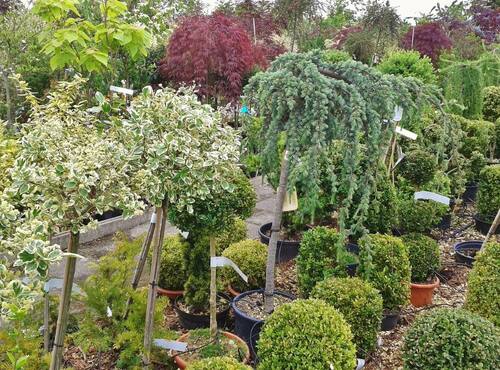
A Wide Selection of Nursery Trees – Photo by cocoparisienne on Pixabay
When selecting trees to support urban wildlife, keep these factors in mind:
- Native vs. Nonnative Species: Native species are often the best choice as they’re adapted to local conditions and support native wildlife. However, some nonnative species can also provide benefits if chosen carefully.
- Seasonal Food Availability: Choose trees that offer food sources throughout the year, such as spring flowers for pollinators , summer fruits for birds, and winter seeds for resident species.
- Nesting and Shelter Opportunities: Trees with dense foliage, cavities, or peeling bark provide excellent nesting sites and shelter for various animals.
- Adaptability to Urban Conditions: Select species that can tolerate pollution, compacted soils, and limited root space common in urban environments.
- Size and Growth Rate: Consider the mature size of the tree and its growth rate to ensure it fits well in the intended space.
- Maintenance Requirements: Choose trees that are relatively low-maintenance to ensure long-term success in urban settings.
Top 5 Best Trees for Urban Wildlife
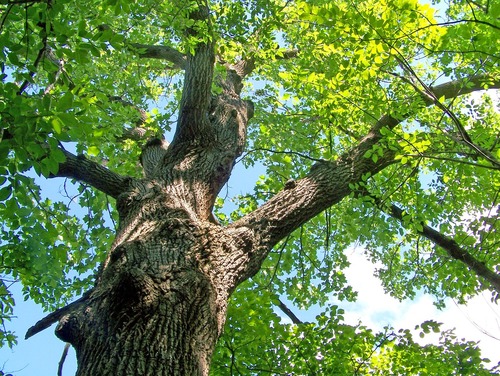
An Oak Tree Towers Over the Landscape – Image by PublicDomainPictures on Pixabay
Now, let’s get to the heart of the matter—the top five tree species that are champions for urban wildlife support in 2024.
1. Oak Trees
Oaks are the undisputed kings of biodiversity support. A single mature oak can host up to 2,300 different species!
Why Oaks Are Great for Wildlife:
- Acorn production provides food for mammals and birds
- Leaves support numerous caterpillar species, which in turn feed birds
- Bark offers habitat for insects and foraging opportunities for woodpeckers
- Large canopies provide excellent nesting sites for birds and squirrels
- Fallen leaves create a rich ecosystem for ground-dwelling insects and small animals
Best Oak Species for Urban Environments:
- White Oak: Tolerates a wide range of soil conditions and provides excellent wildlife value
- Pin Oak: Adapts well to urban conditions and has an attractive pyramidal shape
- Bur Oak: Highly adaptable and drought resistant, with large acorns favored by wildlife
These species are adaptable to urban conditions and provide excellent wildlife support. When planting oaks, be patient—they may grow slowly at first but will provide incredible benefits for decades to come.
2. Maple Trees
Maples are versatile trees that offer benefits to wildlife throughout the year.
Wildlife Benefits of Maples:
- Early spring flowers attract pollinators like bees and butterflies
- Winged seeds (samaras) provide food for birds and small mammals
- Dense foliage offers nesting sites for birds and shelter for various species
- Autumn leaves support a variety of insect species, which in turn feed birds
- Some species, like sugar maples, provide sap that attracts early spring wildlife
Urban-Friendly Maple Varieties:
- Red Maple: Fast-growing and adaptable to various soil conditions
- Sugar Maple: Provides excellent shade and beautiful fall color
- Japanese Maple: Ideal for smaller spaces and adds aesthetic value
Maples are excellent choices for urban environments due to their adaptability and year-round wildlife benefits. They also provide beautiful fall colors, enhancing the aesthetic appeal of city landscapes.
3. Cherry Trees

A Cherry Tree in Full Bloom
Cherry trees are not just beautiful; they’re also wildlife magnets.
How Cherry Trees Support Urban Wildlife:
- Spring blossoms provide early-season nectar for pollinators like bees and butterflies
- Fruits feed birds and mammals throughout the summer
- Leaves host various caterpillar species, supporting the food chain
- Dense canopies offer nesting sites and shelter for birds
- Bark provides habitat for insects, which in turn attract insectivorous birds
Best Cherry Species for Cities:
- Black Cherry: Native species that produces abundant fruit for wildlife
- Chokecherry: Hardy and adaptable, with fruits that persist into winter
- Yoshino Cherry: Ornamental variety with spectacular spring blooms
Cherry trees not only support wildlife but also add beauty to urban landscapes with their stunning spring blossoms. They’re particularly valuable for early-season pollinators when other food sources may be scarce.
4. Birch Trees
Birches are excellent multipurpose trees for urban wildlife support.
Birch Tree Wildlife Benefits:
- Catkins and seeds provide food for birds, especially in winter
- Bark is a favorite for insect-eating birds like nuthatches and woodpeckers
- Leaves support numerous moth and butterfly species
- Branches offer excellent nesting sites for small birds
- Decaying wood provides habitat for beneficial insects and fungi
Birch Species Suitable for Urban Areas:
- River Birch: Heat tolerant and resistant to bronze birch borer
- Paper Birch: Striking white bark and good wildlife value
- Yellow Birch: Aromatic leaves and twigs attract wildlife
Birches are particularly valuable in urban settings due to their ability to thrive in moist soils, making them excellent choices for rain gardens or areas with poor drainage.
5. Serviceberry Trees
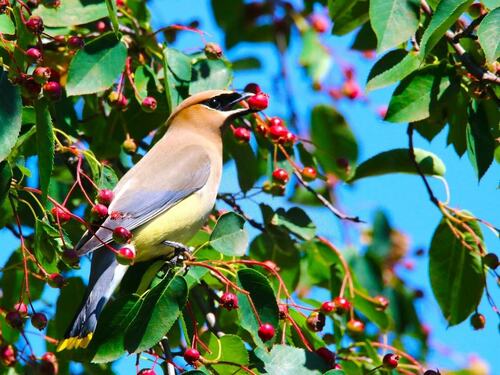
A Bird Enjoys Ripe Serviceberries – Image by Divadan from Pixabay
Serviceberries are small trees that pack a big punch for wildlife support.
Why Serviceberries Are Great for Urban Wildlife:
- Early spring flowers support pollinators when few other sources are available
- Berries provide summer food for birds and mammals
- Compact size makes them suitable in small urban gardens and under power lines
- Attractive fall foliage adds aesthetic value to urban landscapes
- Multiple stems provide excellent nesting sites for small birds
Recommended Serviceberry Species:
- Downy Serviceberry: Native species with excellent wildlife value
- Saskatoon Serviceberry: Drought tolerant and produces edible berries
- Allegheny Serviceberry: Elegant form with showy flowers and fruit
Serviceberries are ideal for creating multilayered urban forests, as they can be planted beneath larger trees to provide additional habitat complexity.
Planting and Care Tips for Urban Wildlife Trees
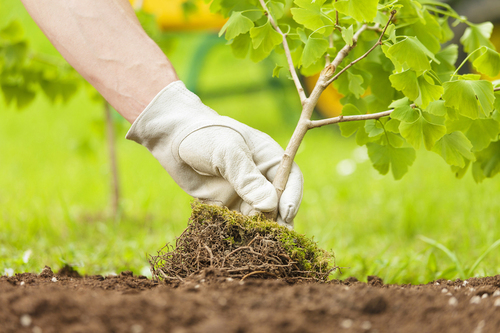
A Gingko Sapling is Carefully Planted in the Ground
To ensure your wildlife-friendly trees thrive in urban environments, follow these tips:
Proper Planting Techniques
- Choose the right location based on the tree’s mature size and sunlight requirements
- Dig a hole two to three times wider than the root ball but no deeper
- Plant at the same depth as the tree was grown in the nursery
- Water thoroughly after planting and mulch around the base, keeping mulch away from the trunk
- Stake only if necessary, and remove stakes after one growing season
Watering and Fertilization Guidelines
- Water deeply and less frequently to encourage deep root growth
- Use slow-release organic fertilizers if needed, especially in poor urban soils
- Avoid overfertilizing, which can harm trees and wildlife
- Monitor soil moisture, especially during the first few years after planting
- Consider installing a drip irrigation system for efficient watering in dry climates
Pruning for Wildlife Habitat Enhancement
- Retain dead branches when safe to do so, as they provide insect habitat
- Prune in late winter or early spring to avoid disturbing nesting wildlife
- Create brush piles with pruned branches to provide shelter for small animals
- Avoid “topping” trees, as this can lead to weak growth and reduces wildlife value
- Consider wildlife needs when pruning—some messiness can be beneficial
Managing Pests and Diseases Naturally
- Encourage natural predators like birds and beneficial insects
- Use organic pest control methods when necessary
- Maintain tree health through proper care to increase resistance to pests and diseases
- Monitor trees regularly for signs of stress or infestation
- Consider companion planting to deter pests and attract beneficial insects
Combining Tree Species for Maximum Wildlife Support
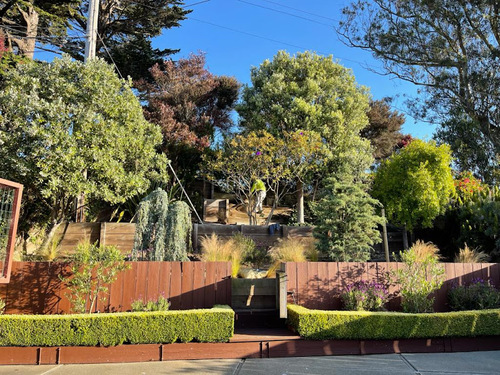
A Landscaped Backyard with a Variety of Tree Species
To create a thriving urban ecosystem, consider planting a variety of tree species:
Creating Diverse Urban Forests
- Mix deciduous and evergreen trees for year-round benefits
- Include trees with different mature heights to create vertical diversity
- Plant trees that fruit or flower at different times of the year
- Incorporate a variety of native species to support local wildlife populations
- Consider the specific needs of target wildlife species in your area
Layering Different Tree Species
- Canopy Layer: Tall trees like oaks and maples
- Understory Layer: Smaller trees like serviceberries and dogwoods
- Shrub Layer: Native shrubs to provide additional food and shelter
- Herbaceous Layer: Native wildflowers and grasses for ground-level diversity
Complementary Planting for Year-Round Wildlife Benefits
- Spring: Cherry and serviceberry for early pollinators
- Summer: Oaks and maples for nesting sites and insect food
- Fall: Birches and maples for seed production and fall color
- Winter: Evergreens for shelter and conifers for winter food sources
Future-Proofing Urban Forests: Selecting Resilient Trees

Healthy Trees Line an Urban Sidewalk
As we plan for long-term urban wildlife support, it’s crucial to consider the changing urban environment and how it affects our tree choices and ecosystems.
Adapting Tree Selection for Evolving Urban Conditions
- Choose trees that are adaptable to a range of environmental conditions
- Consider drought-tolerant species for areas expecting increased dry periods
- Look for trees resistant to common urban pests and diseases
- Plant a diverse range of species to increase the overall resilience of the urban forest
Supporting Wildlife Through Environmental Transitions
- Provide water sources, such as bird baths or small ponds, to help wildlife during hot periods
- Create microhabitats with varied sun exposure and moisture levels
- Plant species that fruit or flower at different times to ensure year-round food availability
- Monitor and manage invasive species that may thrive under changing urban conditions
Urban Trees as Environmental Mitigation Tools
- Recognize the role of urban trees in improving air quality
- Use trees to create cool zones in cities, reducing the urban heat island effect
- Implement green infrastructure, such as bioswales with trees, to manage increased stormwater
- Educate the community about the importance of urban trees in creating resilient cities
Long-Term Care and Maintenance for Urban Wildlife Trees

An Arborist Now Expert Performs Tree Maintenance
Ensuring the long-term health of urban trees is crucial for sustaining wildlife habitats. Here are some tips for maintaining your urban wildlife trees over the years:
Regular Health Checks
- Conduct annual inspections of your trees, looking for signs of stress, disease, or pest infestation
- Consider hiring a certified arborist for professional assessments every few years
- Address any issues promptly to prevent them from becoming more serious
Soil Management
- Maintain a layer of organic mulch around the bases of trees to retain moisture and improve soil health
- Avoid compacting soil around tree roots, which can occur from foot traffic or heavy equipment
- Consider periodic soil testing to ensure proper nutrient levels
Adapting Care as Trees Mature
- Adjust watering schedules as trees establish and mature
- Modify pruning practices to suit the changing structure of the growing tree
- Be prepared to thin out or remove some trees if they become overcrowded as they grow
Succession Planning
- Plan for the eventual replacement of short-lived or fast-growing species
- Gradually introduce new trees to maintain a diverse age structure in your urban forest
- Consider how the surrounding urban environment might change over decades and how this could impact your tree choices
Community Engagement and Education

People Celebrate a Community Tree Planting Event
Creating a thriving urban wildlife habitat is not just about planting the right trees—it’s also about fostering community support and understanding. Here are some ways to engage your community in urban wildlife support:
Educational Programs
- Organize workshops on urban wildlife and the importance of trees
- Create interpretive signage near notable wildlife-friendly trees
- Partner with local schools for hands-on learning experiences about urban ecology
Citizen Science Initiatives
- Encourage community members to participate in bird counts or wildlife surveys
- Set up a platform for residents to report wildlife sightings in the neighborhood
- Collaborate with local universities on urban ecology research projects
Community Planting Events
- Organize tree-planting days where residents can help expand the urban forest
- Create a community fruit tree program, where residents can “adopt” and care for fruit-bearing trees
- Establish a neighborhood tree stewardship program to involve residents in ongoing care
Celebrating Urban Wildlife
- Host annual events celebrating local urban wildlife and the trees that support them
- Create a photo contest for the best urban wildlife photography in your area
- Develop a local guidebook or app showcasing wildlife-friendly trees and where to find them
By involving the community in these efforts, you can ensure that the urban wildlife habitat you’re creating will be valued, protected, and expanded for generations to come.
Conclusion
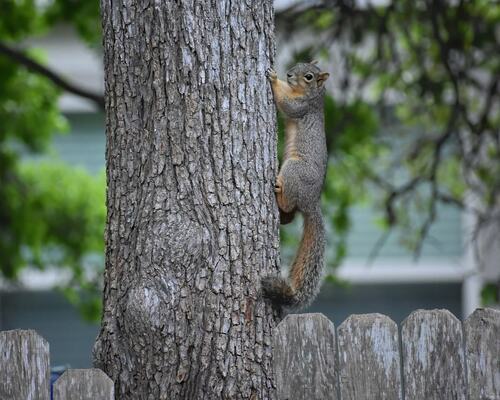
A Squirrel Clings to a Backyard Tree – Photo by Ray Shrewsberry on Pixabay
By choosing the best trees for urban wildlife, you’re not just adding beauty to your city—you’re creating vital ecosystems that support a diverse range of species. The top five trees we’ve explored—oaks, maples, cherries, birches, and serviceberries—offer a fantastic foundation for any urban wildlife habitat.
Remember, every tree planted is a step toward a more biodiverse urban future. By thoughtfully selecting, planting, and caring for trees in our cities, we can create resilient urban ecosystems that benefit both wildlife and humans alike.
For expert advice on selecting, planting, and maintaining the best trees for urban wildlife in the San Francisco Bay Area, contact Arborist Now. Our team of certified arborists can provide personalized recommendations and professional tree care services to ensure your urban wildlife habitat thrives for years to come.
Let’s make 2024 the year our cities truly come alive with the buzz and chirp of thriving urban wildlife. Happy planting!


